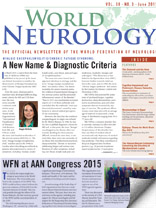By John D. England
On April 21, 2015, the Editorial Board of the Journal of the Neurological Sciences (JNS) met in Washington, DC. I’m pleased to report that by all measures JNS has shown steady and healthy growth. The number of manuscripts that are submitted to the journal has continued to increase over the past several years. Specifically, 1,718 manuscripts were submitted and reviewed in 2014, compared to 1,520 in 2013. Additionally, the number of full text article downloads via Science Direct increased from 764,832 in 2013 to 807,404 in 2014.
By all current indicators, these numbers are expected to increase for 2015. Because JNS is the official journal of the World Federation of Neurology (WFN), the Editorial Board welcomes submissions from around the world. As a measure of this aim, JNS receives articles from authors and institutions around the globe. The majority of submissions come from Asia, Western Europe and North America (U.S. and Canada).
As a reflection of the continuing globalization of science and technology, the journal has seen a significant increase in the number of papers from Eastern Europe, the Middle East and Africa. Although a new impact factor (IF) for the journal will not be calculated until later in 2015, we are hopeful that these positive trends will also result in an increase in the IF over the next few years.
In our ongoing attempt to enhance accessibility of JNS articles to WFN members, we have selected two more “free-access” articles, which are profiled in this issue of World Neurology. These articles are paired and are presented together.
1) Apostolos Safouris, et al, provide an interesting and instructive case description of an older man with probable Alzheimer’s disease who presented with an episode of acute motor aphasia, which was initially diagnosed as a transient ischemic attack (TIA). Although an initial brain CT-scan did not demonstrate an acute lesion, a gradient-echo MRI performed within the first 48 hours revealed a left cortical parietal microbleed (MB). The authors argue persuasively that the MB was probably responsible for the patient’s symptoms and was likely associated with cerebral amyloid angiopathy (CAA). The authors suggest that patients with known or probable CAA (especially those with Alzheimer’s disease) not undergo thrombolysis or anticoagulation for a possible ischemic stroke until amyloid-associated MB is excluded. Safouris A, Gazagnes M-D, Triantafyllou N, Tsivgoulis G. Cerebral amyloid angiopathy-associated microbleed mimicking transient ischemic attack. J Neurol Sci 2015;351:198-199.
2) In an accompanying editorial, Andreas Charidimou provides a succinct and useful perspective on cerebral amyloid disease. He points out that sporadic cerebral amyloid angiopathy (CAA) is a common neuropathological finding in the aging brain, and it is especially notable in the brains of individuals with Alzheimer’s disease. CAA is an important risk factor for spontaneous lobar intracerebral hemorrhage and anticoagulant — associated brain hemorrhage. Dr. Charidimou points out that transient focal neurological spells, sometimes called “amyloid spells,” are well described and probably more common than is generally appreciated. Since these transient episodes can be misdiagnosed as TIAs, he emphasizes the importance of obtaining a brain MRI to exclude a microbleed in the investigation of older individuals with otherwise unexplained transient neurological episodes. Charidimou A. Elderly and forgetful with transient neurological spells: A story of two amyloids? J Neurol Sci 2015;351:1-2.

